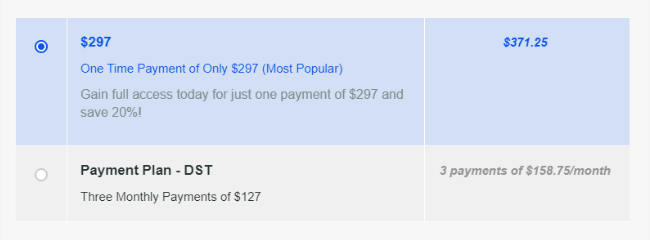
Welcome to my Dropshipping Titans review.
Paul J Lipsky, the creator of Dropshipping Titans promises to teach you how to build a profitable eBay or Facebook dropshipping store.
If you are interested to learn:
- Is it legit or a scam
- How much does it cost to start
- Who is Paul J Lipsky
- Whether students are successful
- And more!
You’ve landed on the best site!
I’ve dedicated a few days to analyzing this dropshipping program, taking notes, and thoroughly going over the content so that I can provide you with the most helpful Dropshipping Titans review.
[wptb id=25216]
I Want To Know…
- About the Reviewer
- Is Dropshipping Titans A Scam?
- What Is Dropshipping Titans Course About?
- Who Is Paul J Lipsky?
- How Does Dropshipping Titans Work?
- What Is Inside Dropshipping Titans Course?
- How Much Does Dropshipping Titans Cost?
- Does Dropshipping Titans Deliver?
- Can You Make Money With Dropshipping Titans?
- Are Students Getting Results?
- Is Dropshipping Titans Worth the Money?
- Who Is Dropshipping Titans Best For?
- Dropshipping Titans Review – Verdict
- The Best Way To Make Money Online
About the Reviewer

Hey, I’m Ivan Brozincevic!
Since 2018, I’ve been making a full-time income online, which allowed me to quit my old job (about me).
In the beginning, I struggled to identify legit courses and avoid ones that were just out for my money.
That’s why I created this website – my main goal is to help you steer clear of pitfalls and discover the top online business courses.
Every week, I invest hours in reviewing online courses and writing reviews based on my fact-driven review guidelines to assist you in making an informed choice.
Related: Check out my FREE training program for making money online.
Is Dropshipping Titans A Scam?
Dropshipping Titans is not a scam. It teaches you how to build a dropshipping business, which is a legitimate way to earn money.
However, the course is more of a basic walkthrough and doesn’t guarantee success. It provides training material, resources, and access to a community, all backed by a money-back guarantee.
That being said, the method of reselling products for low prices on eBay may be outdated and not as effective in generating substantial profits.
It’s important to note that this process might not work for everyone anymore.
Overall, the Dropshipping Titans course is neither exceptional nor terrible. It doesn’t set you up for guaranteed success, but it does provide guidance on building a business.
Keep on reading my Dropshipping Titans review for more information about the course, content, creator, price, pros and cons, and more!
What Is Dropshipping Titans Course About?
Dropshipping Titans is a course created by Paul Joseph that teaches you how to start a dropshipping business through eBay or Facebook. In this course, Joseph will guide you through the process of setting up a successful dropshipping business from scratch.
You will learn essential elements such as creating a website, product procurement, product listing, and other crucial steps to becoming a skilled drop shipper.

Joseph Dropshipping Titans offers a unique approach compared to other dropshipping businesses.
In this course, Joseph focuses on teaching you how to list existing products on eBay. While most courses emphasize buying cheap products from Chinese suppliers to sell at higher margins on eBay or Amazon, Joseph goes beyond that.
He also teaches you how to explore alternative sites to find customers and make a small profit.
However, there’s a challenge.
Over time, eBay has lost its dominance as the number-one dropshipping platform due to tough competition from other sites like Amazon, AliExpress, and Alibaba. These sites offer significantly cheaper products compared to eBay.
Considering this, it’s important to dive into a Dropshipping Titans review to determine if this course is worth investing in or if it might be a scam.
Let’s begin by conducting a background check first.
Who Is Paul J Lipsky?
Paul J Lipsky is an online entrepreneur who claims to have earned a substantial amount of money by reselling products on eBay.
He has a website and a YouTube channel called Paul J Lipsky, which has over 75,000 subscribers. On his channel, he primarily teaches about dropshipping.

When reviewing products like Dropshipping Titans and its owners and creators, it’s always a good sign to see that they have collaborated with other small YouTubers.
If you take a look at some of his videos, you will notice that they are both good quality and informative.

There are countless fake characters and gurus out there. For instance, websites like China Cash Clone and eCom Profit Sniper pretend to be someone they’re not.
On the other hand, there are legitimate entrepreneurs like Paul Joseph who have created valuable courses, such as Ecom Beast 2.0 by Harry Coleman.
If you want to grasp Joseph’s teaching style, here is one video from his YouTube:
All that being said, Paul is a verified drop shipper, so let’s continue reading my review to discover what you can learn from his Dropshipping Titans course.
How Does Dropshipping Titans Work?
The Dropshipping Titans course consists of 10 modules, each covering a different topic related to creating your own dropshipping business.
Each module is designed to guide you through a specific aspect of building your business, gradually forming a complete picture.
Like any other course, the ultimate objective is to generate income online. In drop shipping, your role is to establish a store and offer products in your chosen niche.
However, you won’t need to manage inventory or handle shipping, as major platforms like Amazon, eBay, and AliExpress will handle those aspects on your behalf.
Next, let’s dive into each training module in the upcoming sections of this Dropshipping Titans review.
What Is Inside Dropshipping Titans Course?
Module #1 – Your Life Is About To Change!
Inside Dropshipping Titans, the first module begins with an introduction video by Paul Joseph. In this video, he shares his personal success of making $150,000 in two years.
He claims that you can achieve the same result by following this course.
Module #2 – Get Your Store Up And Running FAST!
This module will teach you how to create your PayPal account, email, and eBay store. The videos in this module, such as the one on setting up your eBay store the right way, are similar to the tutorials you find on YouTube.
Here is a sneak-a-peak into the course:

Module #3 – My Titans Product Research Formula
This module of Dropshipping Titans focuses on product research and is led by Joseph.
It is important to pay attention to this part as it involves browsing Walmart or Home Depot’s website for products that can be sold at a higher price.
However, the entire model lacks uniqueness and many of Joseph’s teachings cover basic product research.
Module #4 – The Perfect eBay Listing
In this module, Joseph will teach you how to list your product on eBay.
However, be aware that eBay has limits for new sellers, allowing them to list only 10 items.
While Joseph focuses on setting up your listing, some important information is missing. It’s funny how his entire Dropshipping Titans course emphasizes quantity over quality but overlooks this crucial aspect.
Module #5 – What You Need To Know Before Listing More Items!
As you already know, new sellers on eBay can initially list up to 10 items. However, if you want to increase your listing limit, you can contact eBay and request an increase. Once your limit has been raised, you’ll be able to sell more items.
Additionally, consider removing items that are not selling well, prioritize getting positive reviews, verify your payment process, and optimize your selling strategy.
In the Dropshipping Titans course, the entirety of module five is summarized in six concise bullet points. While Joseph could have explained it all in one video using PowerPoint, he has chosen to dedicate an entire module to this topic.
Module #6 – Getting Your Customers Their Orders Fast
Similar to the previous module, this one can be summarized in a single point: buy the item for them. Simply take the money they provided and make the purchase through your supplier’s website.
However, in this module, Joseph has included nine different videos that offer step-by-step tutorials on how to check out at Walmart.
Module #7 – Top Customer Service Hacks
In this module, Joseph will cover a range of topics including uploading tracking numbers, answering questions, and avoiding cancellations.
This is a standard customer service process that should not require much explanation.
Essentially, providing good treatment to your customers will result in positive reviews that can impact your eBay account.
Module #8 – Titan Hacks To Double Your Profit On Every Sale
This module of Dropshipping Titans will teach you various strategies to increase your profit margins on each sale.
Joseph covers topics such as:
- Collecting and applying coupons
- Buying products together for free shipping
- Collecting sales tax
- Purchasing discounted gift cards
Additionally, Joseph shares insights on obtaining free shipping for Home Depot products in Dropshipping Titans. This module is designed to help you save pennies on each transaction and develop a healthy profit margin.
Module #9 – Keep Things Organized
The module within the Dropshipping Titans course guides you on effectively using QuickBooks and managing your orders through a spreadsheet.
Module #10 – Advanced Topics
This module doesn’t offer anything special as it only covers the concept of creating multiple stores. Joseph briefly mentions the idea without providing detailed instructions on opening a second store.
The module also touches on topics like forming an LLC and using LegalZoom, as well as strategies for dealing with slow sales.
It’s important to note that there are no advanced topics covered here, just information that can be found on Joseph’s YouTube channel. Moving forward, we’ll explore the costs associated with this course in the next section of my Dropshipping Titans review.
How Much Does Dropshipping Titans Cost?
Dropshipping Titans offers two payment options: a one-time fee of $297 or three payments of $127, which adds up to $381 in total, making it quite expensive.
Additionally, there is an additional charge of $84 for the payment plan option.

Additionally, by enrolling in this course, you will gain access to the private Facebook mastermind group. Collaborate with fellow students and seek assistance directly from Paul.
Furthermore, you will receive free customer service scripts. While these scripts may be valuable for foreign entrepreneurs, they may not be as useful for others.
Can You Get a Refund?
The course offers a 30-day money-back guarantee. To request a refund, simply email Paul himself.
Related: Ecom Dudes Review
Does Dropshipping Titans Deliver?
Dropshipping Titans deliver high-quality content that can help newbies learn about the dropshipping business and start their own enterprise online.
To be honest, it delivers on all its promises stated on the sales page.
You see, on his website, Paul clearly states, “I’m not promising you a million dollars in a year, but I am promising to teach you valuable techniques that will help you build a long-term and profitable dropshipping business!”
Based on the content alone, he is being truthful…
However, it is important to keep in mind that the sales copy and figures presented are only estimates. Those numbers are based on the potential of how much you could earn in this business.
You see, Joseph teaches you how to build a business, not just how to build a successful one.
This entire course serves as a guide on the fundamentals.
That being said, it is up to you to roll up your sleeves, learn from the Dropshipping Titans course (or any other course!), invest a significant amount of time and some money, and patiently wait for the desired results.
There are no guarantees in this business, regardless of what Paul may claim…
Can You Make Money With Dropshipping Titans?
Making money with the Dropshipping Titans program is not as easy as Paul Joseph Lipsky makes it seem. There’s a lot of upfront hard work involved, and success is not guaranteed.
Additionally, substantial sales are necessary to generate significant income with this course.
Essentially, you’ll need to invest considerable time before seeing any results, which applies to any business, whether online or offline.
Are Students Getting Results?
It’s worth noting that there are some students of the course who claim they made money with Dropshipping Titans course.
My Dropshipping Titans review also includes some of these examples.



I want to add that these people are exaggerating a bit. The truth is that online business in any form takes time and, most importantly, requires learning skills and gaining experience.
That being said, expecting the same results in the first few weeks would be unrealistic!
So, here’s my advice: if you plan to join Dropshipping Titans after reading my review, make sure to keep a realistic mindset and don’t expect miracles.
Is Dropshipping Titans Worth the Money?
Joseph’s course is not as effective for achieving success as you might anticipate. Firstly, it mainly consists of simple and obvious walkthroughs.
His claims of others making “thousands of dollars” are misleading and misleading.
Reselling products for minimal profits is a time-consuming and exhausting process that, although it may have worked in the past, is now outdated.
With his techniques, you will face a challenging market with only your eBay account, which must be verified with payment.
Who Is Dropshipping Titans Best For?
The Dropshipping Titans program is designed for those who want to learn more about dropshipping. While the course may seem basic, it may not provide significant value to advanced and existing business owners.
However, it is important to note that this course can be beneficial for anyone else who is interested in the topic.
Dropshipping Titans Review – Verdict
Dropshipping Titans is a good course if you want to learn more about dropshipping.
But is it worth it? Well, here’s my verdict: I do think it has value, but I don’t recommend buying it.
There are plenty of courses available online, including free ones on YouTube and more affordable options on platforms like Udemy.
While the course is good, it could definitely be improved with more advanced content that can’t be found on YouTube. So, to sum up, it’s not a scam, but there are better alternatives out there.
Thanks for reading my Dropshipping Titans review. What do you think about it? Is it a scam or legit?
Share your thoughts and comments below!
[wptb id=25216]
The Best Way To Make Money Online
I earn online by creating simple affiliate websites that I use to connect people with products they are already looking for.
It’s called affiliate marketing and it is the best way to make money online (at least in my humble opinion).
If you want to learn more about how you can start making money online with affiliate marketing, I would strongly suggest you sign up for the free training on the next page.
And don’t forget to share this Dropshipping Titans review with your friends and family!
All the best, Ivan @freeaffiliatemarketingbusiness.com